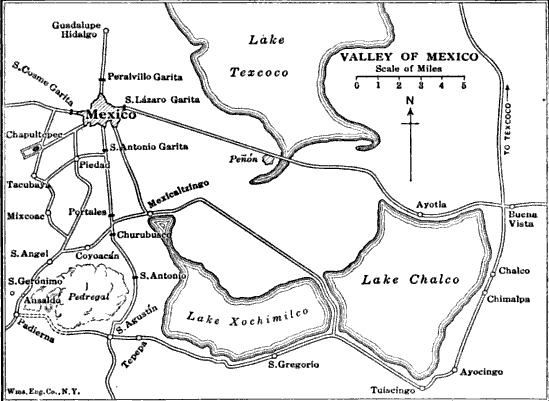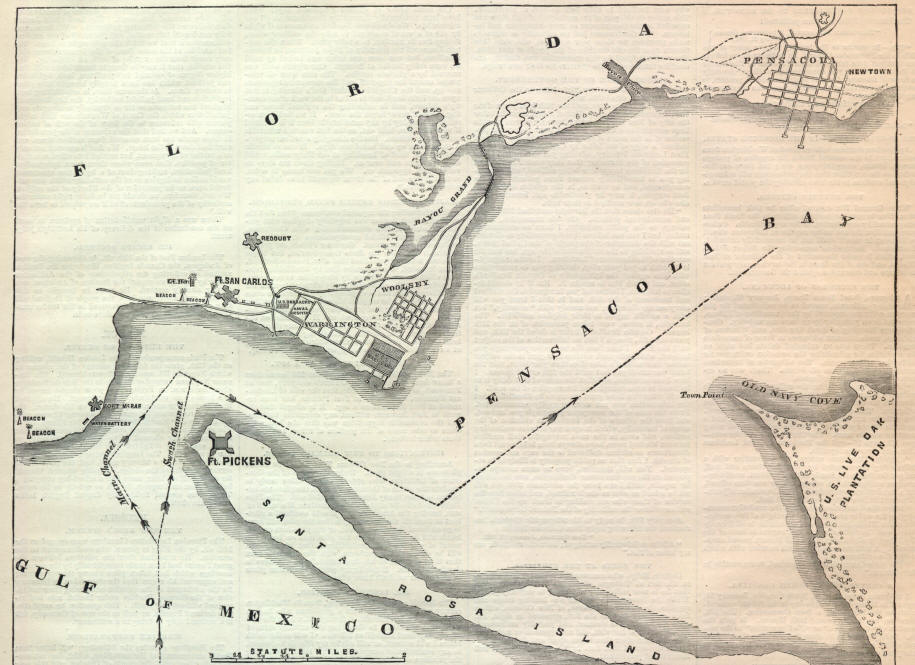|
Lewis Golding Arnold
Lewis Golding Arnold (January 15, 1817 – September 22, 1871) was a career U.S. Army officer and a brigadier general in the Union Army during the American Civil War, primarily noted for his service in Florida. Birth and early years Lewis G. Arnold was born in Perth Amboy, New Jersey and graduated from West Point in 1837, placing tenth in his class. He fought in the Second Seminole War and the Mexican–American War, where he was severely wounded at Chuburusco. After the war, he once again commanded troops in Florida, and led a detachment against the Seminole Indians in the April 1856 Battle of Big Cypress. Civil War service At the onset of the Civil War, he was promoted to Major of the 2nd United States Artillery and was assigned to Fort Jefferson at Dry Tortugas, Florida, in January 1861, leaving his command at Fort Independence, Massachusetts. In October 1861, he helped repulse a Confederate attack on Santa Rosa Island, and defiantly refused to surrender the outpost ... [...More Info...] [...Related Items...] OR: [Wikipedia] [Google] [Baidu] |
Perth Amboy, New Jersey
Perth Amboy is a city (New Jersey), city in Middlesex County, New Jersey, Middlesex County, New Jersey. Perth Amboy is part of the New York metropolitan area. As of the 2020 United States census, 2020 U.S. census, the city's population was 55,436. Perth Amboy has a List of U.S. communities with Hispanic-majority populations in the 2010 census, Hispanic majority population. In the 2010 census, the Race and ethnicity in the United States Census#2010 Census, Hispanic population made up 78.1% of the population, the second-highest in the state, behind Union City, New Jersey, Union City at 84.7%. Perth Amboy is known as the "City by the Bay", referring to its location adjoining Raritan Bay. The earliest residents of the area were the Lenape Native Americans of the United States, Native Americans, who called the point on which the city lies "Ompoge". Perth Amboy was settled in 1683 by Scottish colonists and was called "New Perth" after James Drummond, 4th Earl of Perth; the native name ... [...More Info...] [...Related Items...] OR: [Wikipedia] [Google] [Baidu] |
Battle Of Churubusco
The Battle of Churubusco took place on August 20, 1847, while Santa Anna's army was in retreat from the Battle of Contreras or Battle of Padierna during the Mexican–American War. It was the battle where the San Patricio Battalion, made up largely of US deserters, made their last stand against U.S. forces. The U.S. Army was victorious, outnumbering more than two-to-one the defending Mexican troops. After the battle, the U.S. Army was only 5 miles (8 km) away from Mexico City. 50 Saint Patrick's Battalion members were officially executed by the U.S. Army, all but two by hanging. Collectively, this was the largest mass execution in United States history. Background Following their defeats at Contreras, Antonio López de Santa Anna ordered Major General Nicolás Bravo Rueda with the Army of the Center, to retreat from San Antonio to Churubusco.Bauer, K.J., 1974, ''The Mexican War, 1846-1848'', New York:Macmillan, Santa Anna also ordered Major General Manuel Rincón to ... [...More Info...] [...Related Items...] OR: [Wikipedia] [Google] [Baidu] |
1817 Births
Events January–March * January 1 – Sailing through the Sandwich Islands, Otto von Kotzebue discovers New Year Island. * January 19 – An army of 5,423 soldiers, led by General José de San Martín, starts crossing the Andes from Argentina, to liberate Chile and then Peru. * January 20 – Ram Mohan Roy and David Hare found Hindu College, Calcutta, offering instructions in Western languages and subjects. * February 12 – Battle of Chacabuco: The Argentine–Chilean patriotic army defeats the Spanish. * March 3 ** President James Madison vetoes John C. Calhoun's Bonus Bill. ** The U.S. Congress passes a law to split the Mississippi Territory, after Mississippi drafts a constitution, creating the Alabama Territory, effective in August. * March 4 – James Monroe is sworn in as the fifth President of the United States. * March 21 – The flag of the Pernambucan Revolt is publicly blessed by the dean of Recife Cathedral, Brazil ... [...More Info...] [...Related Items...] OR: [Wikipedia] [Google] [Baidu] |
List Of American Civil War Generals (Union)
Union generals __NOTOC__ The following lists show the names, substantive ranks, and brevet ranks (if applicable) of all general officers who served in the United States Army during the Civil War, in addition to a small selection of lower-ranked officers who received brevets as general officers; while some 1,600 officers received or were nominated for brevets as general officers in the course of the war (or immediately following it for service during the war),Hunt, Roger D. and Brown, Jack R., Brevet Brigadier Generals in Blue. Olde Soldier Books, Inc.,, Gaithersburg, MD, 1990. only a small selection is listed here; only those who were killed in action, served as department heads within the army, had revoked or incomplete appointments or became U.S. President are listed here. In addition to their names and ranks, there is a small set of notes after every entry listing Medal of Honor or Thanks of Congress citations, West Point graduation dates, important political or Army office ... [...More Info...] [...Related Items...] OR: [Wikipedia] [Google] [Baidu] |
New Orleans In The Civil War
New Orleans, Louisiana, was the largest city in the South, providing military supplies and thousands of troops for the Confederate States Army. Its location near the mouth of the Mississippi made it a prime target for the Union, both for controlling the huge waterway and crippling the Confederacy’s vital cotton exports. In April 1862, the West Gulf Blockading Squadron under Captain David Farragut shelled the two substantial forts guarding each of the river-banks, and forced a gap in the defensive boom placed between them. After running the last of the Confederate batteries, they took the surrender of the forts, and soon afterwards the city itself, without further action. The new military governor, Major General Benjamin Butler, proved effective in enforcing civic order, though his methods aroused protest everywhere. One citizen was hanged for tearing down the US flag, and any woman insulting a Federal soldier would be treated as a prostitute. Looting by troops was also rife, th ... [...More Info...] [...Related Items...] OR: [Wikipedia] [Google] [Baidu] |
Artillery
Artillery is a class of heavy military ranged weapons that launch munitions far beyond the range and power of infantry firearms. Early artillery development focused on the ability to breach defensive walls and fortifications during sieges, and led to heavy, fairly immobile siege engines. As technology improved, lighter, more mobile field artillery cannons developed for battlefield use. This development continues today; modern self-propelled artillery vehicles are highly mobile weapons of great versatility generally providing the largest share of an army's total firepower. Originally, the word "artillery" referred to any group of soldiers primarily armed with some form of manufactured weapon or armor. Since the introduction of gunpowder and cannon, "artillery" has largely meant cannons, and in contemporary usage, usually refers to shell-firing guns, howitzers, and mortars (collectively called ''barrel artillery'', ''cannon artillery'', ''gun artillery'', or - a layman t ... [...More Info...] [...Related Items...] OR: [Wikipedia] [Google] [Baidu] |
Battle Of Santa Rosa Island
The Battle of Santa Rosa Island (October 9, 1861) was an unsuccessful Confederate attempt to take Union-held Fort Pickens on Santa Rosa Island, Florida. Background Santa Rosa Island is a 40-mile barrier island in the U.S. state of Florida, thirty miles from the Alabama state border. At the western end stands Fort Pickens, which in the fall of 1861 was garrisoned by parts of the 1st, 2nd, and 5th U. S. artillery and the 3rd U.S. Infantry, under command of Col. Harvey Brown, of the 5th artillery. The 6th New York Volunteer Infantry, commanded by Col. William Wilson, was encamped outside the fort, a short distance east of it. Battle After midnight on October 9, Brig. Gen. Richard Anderson crossed from the mainland to Santa Rosa Island with 1,200 men in two small steamers to surprise the Union troops at Camp Brown and if possible capture Fort Pickens. He landed on the north beach about four miles east of Fort Pickens and divided his command into three columns. After proceedin ... [...More Info...] [...Related Items...] OR: [Wikipedia] [Google] [Baidu] |
Confederate States Army
The Confederate States Army, also called the Confederate Army or the Southern Army, was the military land force of the Confederate States of America (commonly referred to as the Confederacy) during the American Civil War (1861–1865), fighting against the United States forces to win the independence of the Southern states and uphold the institution of slavery. On February 28, 1861, the Provisional Confederate Congress established a provisional volunteer army and gave control over military operations and authority for mustering state forces and volunteers to the newly chosen Confederate president, Jefferson Davis. Davis was a graduate of the U.S. Military Academy, and colonel of a volunteer regiment during the Mexican–American War. He had also been a United States senator from Mississippi and U.S. Secretary of War under President Franklin Pierce. On March 1, 1861, on behalf of the Confederate government, Davis assumed control of the military situation at Charleston, South C ... [...More Info...] [...Related Items...] OR: [Wikipedia] [Google] [Baidu] |
Dry Tortugas, Florida
Dry Tortugas National Park is a national park located about west of Key West in the Gulf of Mexico. The park preserves Fort Jefferson and the seven Dry Tortugas islands, the westernmost and most isolated of the Florida Keys. The archipelago's coral reefs are the least disturbed of the Florida Keys reefs. The park is noted for abundant sea life, tropical bird breeding grounds, colorful coral reefs, and legends of shipwrecks and sunken treasures. The park's centerpiece is Fort Jefferson, a massive but unfinished coastal fortress. Fort Jefferson is the largest brick masonry structure in the Western Hemisphere, and is composed of more than 16 million bricks. Among United States forts it is exceeded in size only by Fort Monroe, Virginia, and Fort Adams, Rhode Island. Dry Tortugas is unique in its combination of a largely undisturbed tropical ecosystem with significant historic artifacts. The park is accessible only by seaplane or boat and has averaged about 63,000 visitors annually ... [...More Info...] [...Related Items...] OR: [Wikipedia] [Google] [Baidu] |






